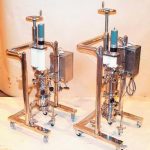Nutsch filters and Nutsch dryers are already well established as standard equipment for separating solids in the chemical and pharmaceutical industries. Semi-automatic Nutsch dryer systems are now also offered for processing small product quantities in the slurry volume range from 1 to 75 l. They close the market gap in the sector for laboratory and pilot applications.
Jürgen Oess
One typical field of application is the separation of active ingredients with a particle size of 1 to 200 µm diameter from slurry batch volumes of 100 to 10 000 l in multi-product plants. The advantage of Nutsch dryers lies in the combination of mechanical and thermal separation technology in just one item of equipment. Nutsch dryers comprise vertically arranged, cylindrical, closed vessels with a flat bottom. The bottom is designed as a filter plate. The slurry discontinuously produced in a reactor is, in most cases, completely drained into the Nutsch dryer. This step is then followed by pressure filtration during which a solids cake builds up on the filter. Inside the vessel is an agitator which is driven from above and has S-shaped mixer arms. The mixer can be axially traversed from top to bottom.
Nutsch dryer in productive operation
During the cake-forming filtration process the agitator is positioned above the filter cake. If crack formation is anticipated in the filter cake prior to displacement washing, the agitator can be used before the washing step to smoothen the surface of the cake. This avoids any non-homogeneous washing as a result of the washing medium bypassing the cake through the cracks.
When slurries with a low solids concentration are separated, cake formation can be avoided through continuous mixing with the agitator in the driven-down position. In this operating mode the equipment acts in the first process stage as a pre-thickener filter. It is also possible to carry out re-slurrying washing by stirring up the filter cake in the washing fluid.
At the end of the filtration and washing process the moist solids are either discharged to other equipment for further processing or dried directly in the Nutsch dryer. Residual moisture is usually removed by contact drying in a vacuum.
Drying in a vacuum
The cylindrical housing and the agitator are heated with liquid heat transfer medium or steam. The heat input to the product for evaporating the solvent takes place through contact with the heated surfaces. The product is mixed continuously to keep the heat transfer as efficient as possible. There is an additional input of mechanical energy as a function of the agitator speed.
To ensure gentle processing of the product, drying should preferably take place in a vacuum in order to keep the process and product temperature as low as possible. It is also possible to dry at atmospheric pres-sure with a continuous flow of purge gas.
The product is discharged at the end of the process via a lateral opening at the lowest point in the process area. Depending on the size of the equipment and the operating requirements, either fully automatic discharge valves with automatic product transport to the next process step are used or glove box systems for direct, dust-free filling into packages.
Laboratory and pilot plant operation
The Nutsch dryer design described above has until now only been available for processing very small slurry batch sizes from 75 to 100 l. Mechanical and thermal separation of solids on a laboratory or pilot plant scale took place in separate equipment, such as a vacuum Nutsch filter for filtration and a drying cabinet for drying. In cooperation with Charles Thompson, Krauss-Maffei now also offers Nutsch dryers for closed processing of batch sizes with a slurry volume of 1 to 75 l in a single piece of equipment. The laboratory and pilot plant Nutsch dryers are designed as mobile units for semi-automatic operation in all the available sizes. The process housing is made up of several segments. It can be dismantled in just a few easy steps for cleaning purposes in strict conformance with safety regulations, and is thus able to meet the requirements for laboratory operation.
The process housing, the drive and the control panel are assembled on a mobile base frame. The version with full pneumatic control offers particular advantages with regard to installation, operating convenience and safety for equipment that is to be installed in potentially explosive atmospheres. Apart from incorporating the process pipes (slurry, filtrate, nitrogen, vacuum supply) in the overall installation, the system merely has to be connected to the compressed air supply to become fully operational. The vapour filter that is nor-mally additionally required for vacuum drying is integrated in the process area, even in the smallest model. All the basic functions of the standard production-size Nutsch dryers can be carried out in the same way in the laboratory and pilot plant equipment.
Mobile equipment units
The concept of the mobile plant for plug and play operation has also been implemented for larger pilot systems and small production units. Krauss-Maffei offers mobile equipment units for slurry volumes up to 200 l, which only require compressed air to operate the drives and the control. This enables easy installation in all production areas, even if they are exposed to potentially explosive atmospheres.
It is therefore now possible to install fully operational systems on a laboratory scale – an option that was previously only available for larger batch volumes. Laboratory users benefit from simple product handling, closed processing of slurries up to the solid material in one piece of equipment and maximum design safety for scaling up production plants.
cpp 421
Share:








